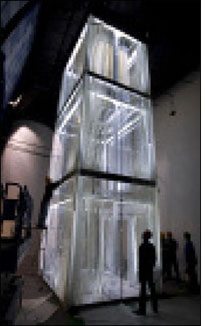World’s Fairs and Expos have long stirred excitement by giving the public a glimpse at cutting-edge technology and promises of other good things to come. The elegant Finland Pavilion at the 2010 World Expo in Shanghai, which ends on Oct. 31, carries on this tradition of introducing innovation.
One unique feature is a Chinese lantern-style elevator that combines forward-thinking Scandinavian design and RFID technology to transport visitors to their desired destinations.
Employees in the pavilion carry small, black VisualRFID destination cards to identify visitors’ current locations. Each card contains a battery-assisted UHF EPC Gen 2 transponder, an environmentally friendly battery from Enfucell and a low-cost display that uses technology from E-Ink. When someone wants to go from, say, the first floor to the third, an employee uses buttons on the card to call the elevator, which was designed and built by Kone Technology, one of the world’s largest elevator manufacturers. The RFID transponder communicates with a reader that calls the elevator to the appropriate floor.
The VisualRFID destination card doesn’t represent a huge leap in elevator convenience—its main purpose is simply to demonstrate that RFID can be used to tell people where they are and help them get where they are going. “RFID will enable new and smart solutions in future buildings,” says Jukka Salmikuukka, Kone’s portfolio manager for integrated solutions. “The prototype at the Shanghai Expo introduced this concept to our customers visiting the Expo. Their feedback will play a crucial role when we decide the next developmental steps for the concept. In any case, I see RFID having a big role in future building applications.”
The project was initiated by RFID Lab Finland and implemented by the Helsinki Metropolia University of Applied Sciences. “We wanted to show that RFID could be used to control the flow of people as well as the flow of goods,” says Marko Mattila, Metropolia’s research manager.
The researchers have projects involving airport and retail applications. Low-cost devices could tell passengers which gate to enter in an airport, what time they need to be at the gate and how to get there. Similar devices could provide shoppers with product location information and special promotions. “We are exploring ways RFID can benefit people in the real world, not just goods in the supply chain,” Mattila says.


